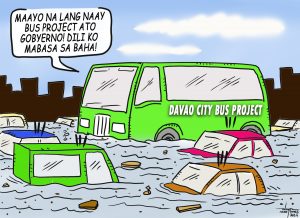In our column for this newspaper’s Saturday and Sunday issues (June 7 and 8, 2024) we harped on the proposed ordinance requiring water users to pay the so-called Payment for Ecological Services (PES). The proponent of the measure is First District Councilor Pilar C. Braga. She called it “innovative” piece of local legislation intended to “protect, restore and to fund ecological management initiatives” by the city government.
In the same column we agreed that indeed the planned ordinance which was considered approved on first reading in the last regular session of the City Council, is indeed innovative. But after some time we realized that it is a piece of local measure patterned after the so-called “environmental tax” levied on power consumers. However, in the Braga proposal, it will only be collected from water consumers in Davao City.
And why are we saying that it is an innovation patterned after the similar tax included in the bills of electric consumers? First it is to be collected to those connected to the Davao City Water District (DCWD). Second, it is computed based on the number of cubic meters of water consumed per month based on the consumer category. That is, whether the consumer is residential or business establishment.
And based on a statement of an official of an environmentalist group who, we believe, is a major influence to Braga’s introduction of the measure, the collected funds will be managed by a special body to be created by the local government.
We also learned that the proponent is scheduling a meeting with the DCWD management to discuss the manner with which the payment of the consumers shall be collected and remitted to the coffers of the city government.
However, there is a difference between the environmental tax on power usage and the proposed PES. According to the proposed measure the amount of the PES to be collected on residential consumers of water will be 25 centavos per cubic meter, while for business or industrial consumers the PES will be 50 centavos per cubic meter. The environmental tax on electricity users is the same regardless of the category of the consumers.
Should the measure be approved to the letter, we warned in our column that it will be a double jeopardy. But we now are entertaining the idea that it would not just be double jeopardy but triple, even quadruple suffering for the ordinary water consumers at the behest of the local government that thinks everyone, persons or juridical entities, be responsible stakeholders of the ecology. And by being “responsible” they have to pay even more through the PES. For certain, the residential water consumers will be the ones subsidizing the business and industrial consumers for the amount they will pay to the local government under the planned ordinance.
After all, it is common knowledge that whatever is added to the business overhead expenses will always be factored in the determination of the cost of their products and services offered to the people most – if not all – of whom are water consumers who have no way of escaping the PES.
And going back to the proposed ordinance as being “innovative,” yes it is. But no, not in terms of addressing the problem of a deteriorating ecology but an innovation in making money for the local government at the expense of its long-impoverished residents who, only recently, suffered the last tranche of the staggered water rate hike imposed by the water distributor firm.
The proposed legislative measure also talks of the money collected to be used to fund programs and projects, as well as management initiatives for the city’s ecology. Does the city, through the City Council, have programs and projects for the mentioned purpose? Can the costs of the projects it has mulled equate the magnitude of the money it can certainly collect through the PES when the ordinance becomes effective?
Just to mention two potential projects as example – the usual that are commonly undertaken by local governments and some private entities – tree planting (or call it re-greening), and coastal clean-up. How will the city make its tree planting activities sustainable when these are more “plant and run” endeavors?
As to the coastal clean-up, it is more a way of getting media mileage for those undertaking the clean-up. Garbage will always continue to find its way to the sea if thrown just anywhere in the city’s waterways and drainage canals. As soon as the garbage are in the open sea the refuse will be brought by the currents to the shores.
Also, in these two supposed environmental protection activities, the communities are not engaged. Rather, they are made “witnesses” to the activities “for posterity” instead of cooperators in ensuring that the planted seedlings grow on their own. Or, that they are goaded to stop dumping garbage to the creeks and rivers that lead to the sea.
Our take, what if the Council, or any of its members, or even the concerned units at the local government’s Executive Department come up first with concrete programs and projects with its attendant costs to justify the proposed ordinance on the collection of the Payment for Ecological Services?
Perhaps it would be easier for the public and the other so-called stakeholders to appreciate the proposed measure? Besides, is it not the norm in government that programs and projects should first be conceptualized and readied to justify the budget being asked for in the appropriations law?


